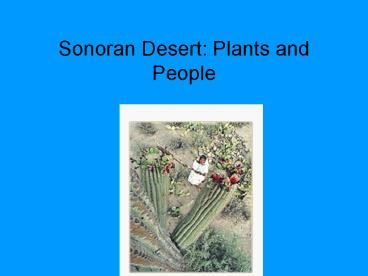Sonoran Desert: Plants and People - PowerPoint PPT Presentation
1 / 15
Title:
Sonoran Desert: Plants and People
Description:
bats, birds) over thousands. of years. Aboriginal people. domesticated some ... Long-nosed bats cross pollination and seed dispersal. Provides fruit and wine ... – PowerPoint PPT presentation
Number of Views:339
Avg rating:3.0/5.0
Title: Sonoran Desert: Plants and People
1
Sonoran Desert Plants and People
2
Sonoran Desert Background
- Extends across Arizona, California
- and Mexico
- Characterized by extreme heat
- and low rainfall
- Mountains surround most of the desert
- Termed an arborescent desert
3
Sonoran Vegetation
- Variety of vegetation
- Important edible plants
- Mesquite, agaves and columnar cacti
- Plants have greatly shaped the cultures within
the Sonoran Desert - Acting as food, cures and characters (in tribal
legends) - Plants have coevolved with
- insects, mammals (rodents,
- bats, birds) over thousands
- of years
- Aboriginal people
- domesticated some plants
- (Ex. Devils claw)
4
Papago Background (Before the arrival of the
Spaniard)
- Seminomatic because of their limited access to
water - Migration between a summer and winter settlement
- Crops harvested in the fall and dried (natural
vegetation) - Gathered wild fruits and nuts
- No domesticated animals
- Lived in balance with the land
5
Native Plants and Sonoran Cultures
- 2500 known plant species
- 425 wild edible plants
- Folklore attached to plants
- Oodham Jimsonweed
- Diet today does not compose
- of strictly wild plants
6
Organpipe Cactus
- Wild edible plant
- Viigita
- Long-nosed bats cross pollination and seed
dispersal - Provides fruit and wine
- During drought seeds provide protein and oil
- Folklore lightning
7
Amaranth Greens
- Meat of the poor
- 100 g of Amaranth Contains
- 3x more calories
- 18x more vitamin A
- 13x more vitamin C
- 20x more calcium
- 7x more iron
- Than 100g of lettuce
- Historically, essential food for Papago
- Many Papago (in California, Mexico and Arizona)
still use the plant today
8
Tepary Beans
- Believed that Papago comes from Papavi Kuadam
Tepary eaters - Record of beans in cultural remains from
pre-pottery times - Women would gather the bean pods early in the
morning before the pods would burst - 1900 Oodhan began to share their knowledge of
the plant with other indigenous people - 1930s harvesting and consumption of the
- tepary beans began to decrease among
- the Papago
- World War two government programs
- provided Papago families with beans
- These beans are much lower in nutritional
- values than the tepary beans (Diabetes)
9
Chilepin
- Greatest protection against evil
- Wild chilepin or bird pepper
- Referred to by the Papago as Iitoi kookol
- Eating chiles causes us to sweat
- Evaporation on the surface of skin makes us feel
cool - In arid regions, shade is rare, gives a sensation
of coolness - Red colour suggested that this is to attract
birds which dispense the seeds - Birds can tolerate the taste, other animals can
not - Used to wean babies
- Popularity of chilepin as a spice is increasing
greater level of harvesting, decreasing abundance
10
Desert Gourds
- Cucurbitacins foul smelling chemical
- found in wild gourds
- Deters animals from eating
- Exception Luperini beetles
- Feast on young gourds
- Keep populations under control and thus eliminate
competition for resource among adult and
developing gourds - Indigenous people use the roots, seeds and leaves
for medicinal purposes - Gourds carved into baskets (this practice has
been traced back to before pottery) - Luperini beetles are a huge agricultural pest on
corn
11
Desert Agriculture
- North American
- Tends to reduce biodiversity
- Based on humid-adapted crops
- Short term productivity
- Degrades soil
- Indigenous
- When compared to other plots
- has a greater level of
- biodiversity
- Tends to use native desert plants
- One mans weed is another mans vegetable, a
Papago might say. And he might be both men at the
same time
12
Edible wild plants impact on biodiversity
- Traditional ecological knowledge
- Communication and exchange of knowledge
- Worldview
- Practices and strategies for sustainable living
- Understanding of ecological knowledge impacts
harvesting of wild plants - Environmental modification
13
Oodham Community Food System
- Goals of the OCFS
- Empower community members to reduce the high
- incidence of adult-onset diabetes within the
- Tohono O'odham Nation
- Contribute to the revitalization of the O'odham
Himdag - the Desert People's Way. - Stimulate sustainable and culturally-appropriate
economic development through food system
development. - Oodham have the highest rate of adult diabetes
in the world - Why?
- Destruction of the traditional food system and
diet - Traditional foods (including tepary beans, cactus
buds and amaranth greens) have been shown to
reduce the effect of diabetes
14
References
- Gathering the Desert. Gary Nabhan. The University
of Arizona Press, Tuscon, Arizona, 1997 - The Sonoran Desert Its Geography, Economy and
People. Roger Sunbier. The University of Arizona
Press, Tuscon, Arizona, 1968. - An Overview of the Sonoran Desert Ecosystem.
http//www.nature.nps.gov/im/units/sodn/sonorandes
ert.htm - Boyce Thompson Arboretum. arboretum.ag.arizona.edu
/ edibleplants.html - Conservation and Native Peoples Kwapa and Tohono
Oodham Community Mapping. http//www.sonoran.org/
programs/sonoran_desert/si_sdep_culture.html - Reviving Native Foods, Health, and Culture the
Tohono Oodham Community Food System.
www.oxfamamerica.org/. ../art4144.html - Sonoran Desert Ecology. http//instruct.uwo.ca/bio
logy/320y/jefes.html - Sonoran Desert Research Station.
www.srnr.arizona.edu/nbs/ - Using Native Desert Seeds. http//www.omick.net/na
tive_foods/native_foods.htm
15
Questions?































